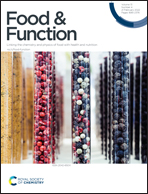Use of kefir peptide (Kef-1) as an emerging approach for the treatment of oxidative stress and inflammation in 2K1C mice
Abstract
The benefits of kefir consumption are partially due to the rich composition of bioactive molecules released from its fermentation. Angiotensin-converting enzyme (ACE) inhibitors are bioactive molecules with potential use in the treatment or prevention of hypertension, heart failure, and myocardial infarction. Here, the in vivo actions of the Kef-1 peptide, an ACE inhibitor derived from kefir, were evaluated in an angiotensin II-dependent hypertension model. The Kef-1 peptide showed a potential anti-hypertensive effect. Additionally, Kef-1 exhibited systemic antioxidant and anti-inflammatory activities. In smooth muscle cells (SMCs), the Kef-1 peptide decreased ROS production through the reduced participation of NADPH oxidase and mitochondria. The aorta of 2K1C mice treated with Kef-1 showed lesser wall-thickening and partial restoration of the endothelial structure. In conclusion, these novel findings highlight the in vivo biological potential of this peptide demonstrating that Kef-1 may be a relevant nutraceutical treatment for cardiovascular diseases.



 Please wait while we load your content...
Please wait while we load your content...